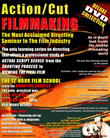|
|
FEATURES
- Film
Editing
|
 |
|
|
|
|
|
|
|
|
| Sponsors |

|
|
|
 |
|
 |

|
|
Film Editing - page 7
|

|
|
The editor must be careful to remove equivalent amounts of picture and sound when trimming a shot, or the film and sound will no longer be in perfect synchronization. If four frames of picture are removed, four frames of sound must be removed. However, an editor can manipulate the sound track to advantage without completely losing sync.
For example, the sound from one shot can be overlapped with the picture of a subsequent shot. The sound accompanying the subsequent shot is spliced into the sound in
midshot after trimming off a portion of its beginning equivalent in length to the overlap from the previous shot.
In film editing, preliminary editing takes the form of rough cutting and tape splicing the
work print. Once the film editing decisions have been finalized, the original film is conformed to the edited
work print. All of the shots from the originally recorded film are permanently spliced into two or more rolls, called A and B (and C and so on) rolls, using a cement splicer which physically welds two overlapping pieces of film together.
In a digital editing room, conforming is the process of assembling a work print to math a sequence in the digital editing system. When you reach the point when you want to screen the movie on film, the conforming stage begins.
|
|

|

|
|
Digital editing systems provide instantaneous access to every frame of a movie, the ability to simultaneously share the same material on multiple workstations
|
|

|
|
Digital editing systems do not physically cut movies, people do. Cut lists are the maps that we use to link the digital world to the film world. Film cut lists are utilized for conforming the work picture, cutting the negative, and ordering the
opticals. Generating cut lists is fairly simple and does not take much time. Learning how to make them properly does take time.
The revolution in digital editing has changed the way in which we edit movies today. Digital editing systems provide instantaneous access to every frame of a movie, the ability to simultaneously share the same material on multiple workstations, and the ability to preview simple to complex
opticals. None of these changes have eliminated the film editing room. As long as movies are released on film, we will continue to shoot and edit movies on celluloid.
Film dailies still have to be synced and screened each day. The footage has to be logged and coded, boxed and organized, and screened and cleaned. Unless celluloid is completely eliminated from the filmmaking process the protocol for organizing film dailies will remain unchanged.
After the lab processes the negative film and prints the takes, the dailies are generally broken down into 1000-foot roles and the takes are logged into a codebook. Next, the film dailies are digitized and organized in a digital program (ex. Avid).
|
|

|
|
|
|
|
|
|
|

|
|
|

|

|
|
top of page
|
Home
Page |
Contests
| Indies
| Features
| News
| Resource
Links
| Advertise
With Us |
Important
disclaimer
Copyright ©
1999-2011 by FilmMakers.com. All rights reserved.
FilmMakers.com
is a division of Media Pro Tech Inc.
|

|
|
|